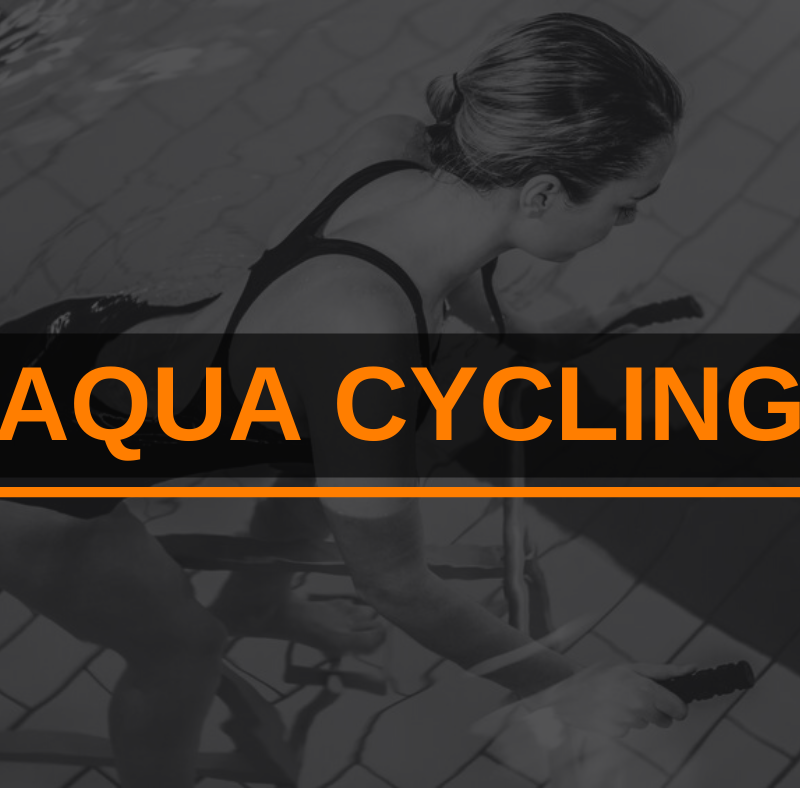
Cyclists are taking to the water! Aqua cycling, the new fitness “wave”, creates a workout that offers both high-intensity cardio and strengthening. Learn how pedaling against the resistance of water creates a unique alternative to land-anchored studios!
History of Aqua Cycling
Originating in Europe, aqua cycling first came to the attention of therapists while helping clients with chronic knee pain. Over time, this rehab method has soared in popularity not just with injured athletes, but among fitness enthusiasts seeking an innovative exercise adventure.
Criselda Esguerra, PT aid and AquaCycle instructor, describes aqua cycling as “a fine line between fitness and rehab”. When she leads a class, her focus includes back and core strengthening, stretching and proper breathing techniques.
Methods of Motion
The marine steel used to build most aquatic bikes helps keep them submerged in the water while thwarting the development of rust. Such a material choice renders aqua cycling ideal for classes offered in salt or mineral water.
A typical aqua cycle class takes place in 3- 4 feet of water, on specialized bikes attached to the pool floor with suction cups. Most 45 to 60 -minute classes incorporate some sprints, performed both standing and sitting, much like a traditional land-based cycling experience. While touted as a definite challenge by most participants, novices and seasoned veterans alike, the benefits definitely make the difficulty worthwhile.
Aqua Advantages
While I have not yet tried this exciting new exercise dynamic, I have successfully taught water aerobics to a variety of participants, from young pregnant women to physically challenged senior adults. The benefits of aqua cycling mirror everything we experienced in a traditional class, along with some interesting additional perks:
- Joints endure significantly less stress, due to water’s buoyancy
- A reduction in lactic acid production, coupled with the massaging aspect of moving through water, decreases post-workout soreness, or DOMS
- The resistance of water improves posture, muscle elasticity and flexibility
- Water accelerates the circulation of blood, allowing participants to burn as many as 800 calories during a 1-hour class
- No perception of exercise-induced “hangovers”
- Some studies indicate the potential reduction of blood pressure, and even cellulite
- Ideal for those individuals seeking low-impact exercise for rehab following surgery or injury
When to Schedule Classes
Despite the arduous effort required, warm-water workouts tend to leave participants relaxed and soothed instead of sore. Aqua cycling instructor Esguerra observed a higher attendance in her evening classes; she feels strongly that the unique nature of such movement helps in managing insomnia. Even with heated water, the environment feels cooler than inside a gym spin studio. Water regulates the body’s temperature, preventing the chances of overheating. Less sweating leads to feeling calm and energized rather than drained upon completion of an aqua cycle class.
According to Ms. Amanda Dale, a certified personal trainer and group exercise instructor, aqua cycling offers a great caloric burn while allowing one to remain at a comfortable rate of perceived exertion. If time crunches or scheduling issues challenge one’s busy lifestyle, keep in mind that an aqua cycle class provides a more efficient workout than traditional land-based exercise, in the same amount of time.
No Pain Equals All Gain
Many, if not most, traditional workouts tend to purposely induce muscular exhaustion/failure. While experts cannot argue that this method fosters strength, an athlete also runs the risk of trauma injuries and muscular tears. Water exercises in general, and aqua cycle in particular, tend to sidestep this issue while still allowing participants to cultivate strength.
Studies offered mixed results in regard to whether aqua cycling truly offers all of the benefits extolled by expert instructors. While more scientific research will yield these and additional answers, aqua cycling fits the definition of a fun, safe, creative and unique workout!
References:
www.shape.com/fitness/trends/aquacycling-fitness-trend-you-need-try
exerciserig.com/aqua-cycling/
www.vivotion.com/blog/aqua-cycling-fitness-trend/
www.simplyhealth.co.uk/sh/pages/healthy-you/why-is-aqua-spinning-the-next-big-thing
greatist.com/fitness/aqua-spin-studio#1
www.prevention.com/fitness/g29993557/fitness-trends-2020/?slide=20
https://www.latimes.com/health/la-he-aquacycle-20170902-htmlstory.html







